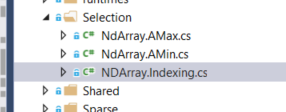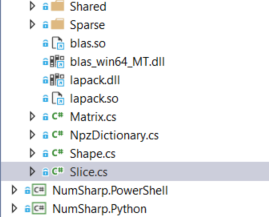NumSharp
 NumSharp copied to clipboard
NumSharp copied to clipboard
How to mimic Python's nice column and row access (i.e matrix[:, 2])?
Hey all,
How would you say to do access to a column matrix[:, i] or access to a row matrix[i, :] in NumSharp?
I need to be able to get a (n-1)-dimensional slice of a n-dimensional matrix, i.e. a 1d vector out of a 2d matrix. First step would be to add appropriate accessors to IStorage right? I am not yet sure how they should look like, please comment if you have ideas.
This is not as elegantly possible as in Python, but we can do something like this, given that matrix is an NDArray:
- matrix[Range.All, 1] ... return the first column, Python: matrix[:, 1]
- matrix[new Range(0, 2), 1] ... return the first two entries of the first column, Python: matrix[:2, 1]
- matrix[new Range(1,3), new Range(1,3)] ... return a 2x2 submatrix of matrix starting at 1,1, Python: matrix[1:3, 1:3]
Check indexing to help.

We can override in Slice

Or we can pass string ":1".
Yeah, the string idea is great for porting code from Python. I am sure it will be popular.
Seem's like another contributor already implemented the string index. I'll found out later. @PppBr is that true?
when you slice a matrix in numpy you essentially get a view of the original data. modifying it will modify the original matrix. Do we have a view concept or implementation already?
Not yet, we havn't have the view class. I've an idea how to implement the new view.
view inherit from ndarray, but keep a filter of data index.
and view will implement a IEnumerate interface.
when interating the view, it will return all the element in the filter.
and view don't need copy the memory. change data will reflect in the original memory.
@henon What do you think of it?
or we need a new NDStorage?
@Oceania2018: I think the projection from the view to the original data could be handled entirely by the storage.
This is complicated, I had to think about it for a time to wrap my head around it. If I am correct, what you need is a function that projects a view index onto an index on the original data (which could be another view that does further projection - think about that).
I am not yet sure how that function looks like if you i.e. for instance get a 1D slice out of a 17-dimensional matrix but once we have that generic formula we can easily project view_index to underlying data_index and view_index+1, view_index+2, ... etc. to enumerate it.
Actually, we have the formula to convert n-d index to 1d index and wise-verse.
chech the function Shape.GetDimIndexOutShape
So don't worry about the dimension. the storage is persistent data in 1d array.
I still think the view should inherit from ndarray with a filters in view instance, not in ndstorage level. Let's keep this talk open.
Nice we have the projection and the inverse projection already, so the difficult part is actually already solved. The rest is just software design.
One thing I missed, that the view also needs to enumerate on the underlying data (or view), is a stride. If you take a row out of a matrix the stride is 1, but if you take a column, the stride is the width of the matrix.
ok, you may be right about inheriting from ndarray. I have only limited knowledge about the design at this point, so I trust your judgement.
I will write the first version of view, then we can discuss further.
Don't forget to make the design recursive, so that you can have a view of a view of a view of a 'storage'.
Sure
Update: Python's slice notation for accessing slices of NDArray has been implemented. However, the implementation of a view that serves that slice of the original data still needs to be done.
Here is a very simple test case that demonstrates the problem to be solved:
public void GetAColumnOf2dMatrix()
{
var x = np.arange(9).reshape(3, 3);
var v = x[":, 1"];
Assert.IsTrue(Enumerable.SequenceEqual( v.Data<double>(), new double[]{ 1, 4, 7 }));
v[1] = 99;
Assert.AreEqual(99, x[1,1]);
}
Check the Slice3x2x2 UnitTest.
I have been wrestling with the same (or similar) issue in the context of trying to generate randomized mini-batches using NumSharp. The python code I am trying to emulate looks like this:
def random_mini_batches(X, Y, mini_batch_size = 64): """ Creates a list of random minibatches from (X, Y)
Arguments:
X -- input data, of shape (input size, number of examples)
Y -- true "label" vector of shape (1, number of examples)
mini_batch_size - size of the mini-batches, integer
Returns:
mini_batches -- list of synchronous (mini_batch_X, mini_batch_Y)
"""
m = X.shape[1] # number of training examples
mini_batches = []
# Step 1: Shuffle (X, Y)
permutation = list(np.random.permutation(m))
shuffled_X = X[:, permutation]
shuffled_Y = Y[:, permutation].reshape((Y.shape[0],m))
# Step 2: Partition (shuffled_X, shuffled_Y). Minus the end case.
num_complete_minibatches = math.floor(m/mini_batch_size) # number of mini batches of size mini_batch_size in your partitionning
for k in range(0, num_complete_minibatches):
mini_batch_X = shuffled_X[:, k * mini_batch_size : k * mini_batch_size + mini_batch_size]
mini_batch_Y = shuffled_Y[:, k * mini_batch_size : k * mini_batch_size + mini_batch_size]
mini_batch = (mini_batch_X, mini_batch_Y)
mini_batches.append(mini_batch)
# Handling the end case (last mini-batch < mini_batch_size)
if m % mini_batch_size != 0:
mini_batch_X = shuffled_X[:, num_complete_minibatches * mini_batch_size : m]
mini_batch_Y = shuffled_Y[:, num_complete_minibatches * mini_batch_size : m]
mini_batch = (mini_batch_X, mini_batch_Y)
mini_batches.append(mini_batch)
return mini_batches
The part I have trouble emulating with NumSharp is:
shuffled_X = X[:, permutation]
shuffled_Y = Y[:, permutation].reshape((Y.shape[0],m))
The closest I have been able to get is:
var shuffled_X = new NDArray(np.float32, X.shape);
for (int i = 0; i < X.shape[0]; i++)
{
shuffled_X[i] = X[i][permutation];
}
var shuffled_Y = new NDArray(np.float32, Y.shape);
for (int i = 0; i < Y.shape[0]; i++)
{
shuffled_Y[i] = Y[i][permutation];
}
shuffled_Y = shuffled_Y.reshape((Y.shape[0], m));
Which works, but is much, much slower (also true when I implement the alternative in Python).
The problem with NumSharp is that I cannot put the indexer ":, permutation" in quotes. I've tried converting 'permutation' to its string-expanded list equivalent (so that I can have a totally string-based indexer that NumSharp likes) but I don't seem to be able to arrive at a string-serialized encoding of 'permutation' inside the resulting indexer that doesn't make NumSharp crash.
Am I overlooking an obvious solution here?
@BillyDJr Try
shuffled_X = X[Slice.All, new Slice(permutation)];
Trying that yielded:
NumSharp.IncorrectShapeException: 'This method does not work with this shape or was not already implemented.'
@BillyDJr Try
shuffled_X = X[Slice.All, new Slice(permutation)];
No, he needs index access to get shuffled data. It should be
shuffled_X = X[Slice.All, new NDArray(permutation)];
I simplified my Python target test case, showing two ways to generate the shuffled Xs and Ys. m = 4 X = np.random.rand(3,m) Y = np.random.rand(1,m) permutation = list(np.random.permutation(m)) print ("perm: " + str(permutation)) print ("X: " + str(X)) print ("Y: " + str(Y)) shuffled_X1 = X[:, permutation] shuffled_X2 = X.copy() for i in range(0, X.shape[0]): shuffled_X2[i] = X[i][permutation]
print("shuffled_X1: " + str(shuffled_X1)) print("shuffled_X2: " + str(shuffled_X2))
shuffled_Y1 = Y[:, permutation].reshape((Y.shape[0],m)) shuffled_Y2 = Y.copy() for i in range(0, Y.shape[0]): shuffled_Y2[i] = Y[i][permutation] shuffled_Y2 = shuffled_Y2.reshape((Y.shape[0], m))
print("shuffled_Y1 " + str(shuffled_Y1)) print("shuffled_Y2 " + str(shuffled_Y2))
And the results: perm: [2, 1, 3, 0] X: [[0.14038694 0.19810149 0.80074457 0.96826158] [0.31342418 0.69232262 0.87638915 0.89460666] [0.08504421 0.03905478 0.16983042 0.8781425 ]] Y: [[0.09834683 0.42110763 0.95788953 0.53316528]] shuffled_X1: [[0.80074457 0.19810149 0.96826158 0.14038694] [0.87638915 0.69232262 0.89460666 0.31342418] [0.16983042 0.03905478 0.8781425 0.08504421]] shuffled_X2: [[0.80074457 0.19810149 0.96826158 0.14038694] [0.87638915 0.69232262 0.89460666 0.31342418] [0.16983042 0.03905478 0.8781425 0.08504421]] shuffled_Y1 [[0.95788953 0.42110763 0.53316528 0.09834683]] shuffled_Y2 [[0.95788953 0.42110763 0.53316528 0.09834683]]
Here is the C# code (just showing the Xs for the sake of brevity). Note the shuffled_X2 works (as I reported before, but it runs too slowly for large datasets). As you can see, I try various stabs at arriving at shuffled_X1, all failing:
var m = 4;
var X = np.random.rand(3, m);
var permutation = np.random.permutation(m);
print($"perm: {permutation}");
print($"X: {X}");
// In Python: shuffled_X1 = X[:, permutation]
try
{
var shuffled_X1 = X[Slice.All, permutation];
print($"shuffled_X1: {shuffled_X1}");
}
catch (Exception ex)
{
print($"Param as: raw permutation - error: {ex.Message}");
}
try
{
var shuffled_X1 = X[Slice.All, new Slice(permutation)];
print($"shuffled_X1: {shuffled_X1}");
}
catch (Exception ex)
{
print($"Param as: new Slice(permutation) - error: {ex.Message}");
}
try
{
var shuffled_X1 = X[Slice.All, new NDArray(permutation.ToArray<Int32>())];
print($"shuffled_X1: {shuffled_X1}");
}
catch (Exception ex)
{
print($"Param as: new NDArray(permutation.ToArray<Int32>()) - error: {ex.Message}");
}
try
{
var shuffled_X1 = X[Slice.All, new NDArray(permutation.CloneData())];
print($"shuffled_X1: {shuffled_X1}");
}
catch (Exception ex)
{
print($"Param as: new NDArray(permutation.CloneData()) - error: {ex.Message}");
}
try
{
var shuffled_X1 = X[Slice.All, new NDArray(Binding.list(permutation.ToArray<Int32>()))];
print($"shuffled_X1: {shuffled_X1}");
}
catch (Exception ex)
{
print($"Param as: new NDArray(Binding.list(permutation.ToArray<Int32>())) - error: {ex.Message}");
}
var shuffled_X2 = new NDArray(np.float32, X.shape);
for (int i=0; i<X.shape[0]; i++)
shuffled_X2[i] = X[i][permutation];
print($"shuffled_X2: {shuffled_X2}");
And the results: perm: [2, 1, 0, 3] X: [[0.5201029277034583, 0.8834703261421389, 0.034344740227956666, 0.5556772460954623], [0.3361533942335068, 0.780603283914087, 0.6067406924472846, 0.794946916305901], [0.8351871454320788, 0.11560027912054224, 0.601820489671929, 0.2805163801091334]] Param as: raw permutation - error: shape mismatch: objects cannot be broadcast to a single shape Param as: new Slice(permutation) - error: This method does not work with this shape or was not already implemented. Param as: new NDArray(permutation.ToArray<Int32>()) - error: shape mismatch: objects cannot be broadcast to a single shape Param as: new NDArray(permutation.CloneData()) - error: shape mismatch: objects cannot be broadcast to a single shape Param as: new NDArray(Binding.list(permutation.ToArray<Int32>())) - error: shape mismatch: objects cannot be broadcast to a single shape shuffled_X2: [[0.03434474, 0.8834703, 0.5201029, 0.55567724], [0.6067407, 0.7806033, 0.3361534, 0.7949469], [0.60182047, 0.11560028, 0.83518714, 0.2805164]]
Are there any other variations I should try?
FWIW....It was easy to get working with Numpy.NET:
[TestMethod]
public void mytest() {
var m = 4;
var X = np.random.rand(3, m);
var permutation = np.random.permutation(m);
print($"perm: {permutation}");
print($"X: {X}");
var shuffled_X = X[":", permutation];
print($"shuffled_X: {shuffled_X}");
}
private void print (string output)
{
System.Diagnostics.Debug.WriteLine(output);
}
Resulted in:
perm: [3 0 1 2]
X: [[0.58033439 0.99341353 0.77685615 0.1893294 ]
[0.81824309 0.7315536 0.64120989 0.97876454]
[0.15659539 0.9045345 0.83839889 0.43254176]]
shuffled_X: [[0.1893294 0.58033439 0.99341353 0.77685615]
[0.97876454 0.81824309 0.7315536 0.64120989]
[0.43254176 0.15659539 0.9045345 0.83839889]]
Now I'm off to investigate if there is an efficient way that I can use Nump.NET NDArrays for my mini-batch randomization in TensorFlow.NET. (I'm admittedly just hacking away here....please stop me, anyone, if you think there is a better way.)
Obviously, this should also work in NumSharp, but there seems to be a bug somewhere.
Ok. Thanks. I will keep my eye out for the resolution, once it appears, so that i might switch over.